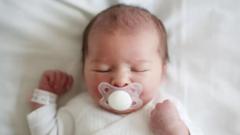Is Scotland's Birth Rate Plummeting to Historic Lows?

Published: 2025-08-26 11:21:26 | Category: technology
The number of babies born in Scotland reached a historic low in 2024, according to official statistics from the National Records of Scotland (NRS). With only 45,763 live births registered, this marks a decrease from the previous year and the lowest figure since records began in 1855. The decline in the total fertility rate, now at 1.25, highlights significant demographic shifts in the nation.
Last updated: 27 October 2023 (BST)
Key Takeaways
- In 2024, Scotland recorded 45,763 live births, the lowest since 1855.
- The total fertility rate fell to 1.25, well below the replacement level of 2.1.
- More than a third of births were to mothers aged 30 to 34.
- Over half of births (51.7%) were to unmarried parents.
- Adoption numbers have remained steady but show a long-term decline.
The Decline in Birth Rates
The latest statistics reveal that Scotland is experiencing a demographic crisis, with a record low number of births. The total fertility rate (TFR) is a crucial indicator of a population's ability to replace itself. For a country to maintain its population without immigration, a TFR of approximately 2.1 is generally required. Scotland's current TFR of 1.25 indicates a significant shortfall, reflecting the broader trends in fertility across the UK.
Historical Context and Trends
Scotland's fertility rates have been on a downward trajectory for several decades. In the 1960s, the average age for mothers giving birth was in their 20s, but this has shifted dramatically. Since 2010, the age bracket of 30 to 34 has become the most common for childbirth, with 35.7% of births last year attributed to women in this age group. This transition points to changing societal norms and economic factors affecting family planning.
Current Fertility Rates Across Scotland
The NRS data further breaks down fertility rates by region, revealing stark contrasts between urban and rural areas. Major cities, including Edinburgh, Glasgow, and Aberdeen, exhibit the lowest fertility rates, with Edinburgh's recorded at just 0.99. In comparison, areas such as Midlothian (1.66), East Renfrewshire (1.56), and Na h-Eileanan Siar (1.51) show significantly higher rates, suggesting that local factors play a crucial role in family size and childbearing trends.
Changing Family Structures
Another noteworthy trend is the increase in births to unmarried parents. Over half of all births in Scotland last year were to parents who were not married, reflecting a shift in societal attitudes towards marriage and child-rearing. This change may also be influenced by economic factors, with many couples opting to delay marriage or choose cohabitation.
Adoption Trends and Statistics
While the number of births has decreased, the adoption figures have shown consistency, with 369 adoptions recorded in 2024, the same as in 2023. However, this stability belies a longer-term decline in adoption rates, indicating that while adoption remains a viable option for many, fewer children are being placed for adoption overall. This trend may reflect changing attitudes towards child-rearing and family structures, as well as the availability of resources and support for biological parents.
Implications for Scotland’s Future
The implications of these demographic changes are significant. With more deaths than births for over a decade, Scotland's population is at risk of decline, which could have far-reaching effects on the economy, healthcare, and social services. The NRS has noted a slight narrowing in the gap between births and deaths, attributed to a static birth rate and fewer deaths in the most recent year. However, the long-term outlook remains concerning if current trends continue.
Government Responses and Policy Considerations
In light of these statistics, policymakers are faced with the challenge of addressing the declining birth rate. Strategies may involve creating supportive environments for families, improving childcare facilities, and offering financial incentives for families to have more children. Additionally, government initiatives could focus on improving healthcare access and support for parents, particularly those in the most affected regions.
The Role of Migration
Migration plays a crucial role in population dynamics. While Scotland's birth rate is declining, immigration can help balance population changes. Encouraging skilled migrants and supporting families in settling can contribute to a more sustainable population structure. Policies aimed at attracting young families to reside in Scotland could also help mitigate the effects of declining fertility rates.
Conclusion
Scotland's record low birth rates signal profound changes in societal norms, family structures, and demographic patterns. Understanding these shifts is essential for developing effective policies to support families and ensure a stable population for the future. As the country navigates these challenges, it will need to consider both the immediate and long-term implications of these trends on its society and economy.
As Scotland faces these demographic shifts, what strategies do you think would be most effective in encouraging higher birth rates? #ScotlandBirthRates #DemographicChanges #FamilyStructures
FAQs
What is the current fertility rate in Scotland?
As of 2024, Scotland's total fertility rate is 1.25, which is below the replacement level of 2.1 needed to maintain the population without immigration.
How many babies were born in Scotland last year?
In 2024, there were 45,763 live births registered in Scotland, marking a decrease from the previous year.
What percentage of births in Scotland are to unmarried parents?
In 2024, over half of all births in Scotland, specifically 51.7%, were to unmarried parents, indicating a shift in family structures.
What are the implications of declining birth rates in Scotland?
Declining birth rates can lead to a shrinking population, which may impact the economy, healthcare, and social services. Long-term strategies are needed to address these challenges.
Are adoption rates increasing or decreasing in Scotland?
While the number of adoptions remained steady at 369 in 2024, there is a longer-term trend showing a decline in adoption rates across Scotland.



